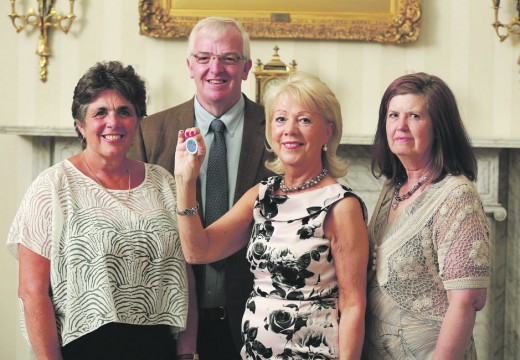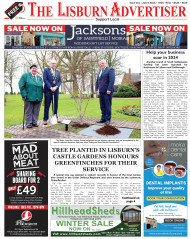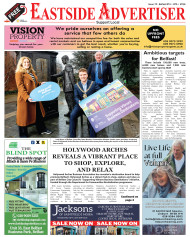Filter by Publication
GRADUATION FOR LOCAL BLUE BADGE TOURIST GUIDES
August 2017 - The East Side Advertiser

Pictured, from left, are Sue McKay, Sam McCallen, Louis McCullough and Catherine Burns.
Four East Belfast people have earned the coveted Blue Badge, acknowledged as the ultimate accolade for professional tourist guides.
Sue McKay, Sam McCallen, Louis McCullough and Catherine Burns were amongst thirty-three people from across Northern Ireland who earned the right to wear the insignia, graduating at a formal ceremony in Belfast’s historic Harbour Office.
The Blue Badge is awarded on the successful completion of intensive training a followed by a series of comprehensive written and practical exams. Blue Badge guides are expected to have at their fingertips an almost encyclopaedic knowledge of history, politics, geology, geography, heritage, arts and culture, and much more besides. They must be capable of guiding visitors confidently, eloquently and in entertaining fashion,around the region’s tourist attractions and landmarks; from Derry’s Walls to Titanic Quarter; from Fermanagh’s Lakes to the Causeway Coast.
The East Belfast candidates came from very different backgrounds – Sue is a retired teacher, Sam is a coach driver, Lois a retail assistant and Catherine an Explainer/Researcher at Hillsborough Castle. They all approached Blue Badge training with enthusiasm, as a way of improving their knowledge and earning a formal qualification, eventually joining an elite group of top guides.
Northern Ireland’s first Blue Badge guides qualified in 1992, graduating from a demanding course which was delivered by Queen’s University Belfast and accredited by the Northern Ireland Tourist Board. The Northern Ireland Tourist Guide Association was established in that same year and has acted ever since as the professional body for Tourist Guides in Northern Ireland.
NITGA Chairperson Cathie McKimm was an original graduate of the class of 1992 and a founding member of the Association. Welcoming the new Blue Badge Guides into the highest rank of their profession she said, “When we originally qualified the first ceasefires were still two years off and no one, but no one, would ever have believed that we would have a tourism industry such as we have today, or that amongst our visitor assets we would include Titanic Belfast which was acclaimed by World Travel Awards as ‘the Best Tourist Attraction In The World 2016’. That was all the stuff of fairy tales, but sometimes fairy tales come true.”
“This year marks our silver anniversary year and what better way to celebrate twenty-five years than with the graduation of thirty-three new Blue Badge Guides. This was the first time that the NITGA has delivered the course and, according to the Institute of Tourist Guiding which is responsible for course accreditation nationwide, our results were amongst the best in the UK.”
Adding her congratulations to the Class Of 2017, Brin Heaton, Course Director and Secretary of the Northern Ireland Tourist Guide Association, said, “The road to Blue Badge status is far from easy, as our students know all too well. Over one intensive year they have visited almost every corner of Northern Ireland to build, then test, their knowledge as they worked towards gaining this internationally recognised qualification for professional tourist guides yet their enthusiasm and thirst for knowledge never faltered. These really are exceptional people and we are confident that they will each play an exceptional role in Northern Ireland’s fast-growing tourism industry.”
The new Blue Badge Guides are already in high demand this season and all feel privileged to see their own country through the eyes of visitors from all around the world. They have also shared how they have been amused and surprised by some of their visitors’ reactions and questions, ranging from ‘Who owns you?’ to ‘Does the Queen have a washing machine?
Although they all covered the same ground in their training, they have each emerged with differing approaches … and different ‘favourite facts’, particularly when it comes to showcasing their native East Belfast.
Retired secondary school teacher Sue McKay from Gilnahirk who has been working for same time as a guide, mainly for cruise visitors, loves the fact that Strandtown Police station used to be the beach, where the wealthy had their bathing huts. She is also a fan of the history behind what is now the Culloden Hotel: Palace Barracks occupies the site of a palatial house known as ‘Ardtullagh’, the home of the Bishop of Down, Connor and Dromore until it was bought by the UK War Officein 1886. The Bishops moved out to what is now the Culloden Hotel. The Culloden was built in 1876 by a Mr William Robinson, JP and former MP. His widow, Lady Elizabeth Jane Culloden, gave the house to the representative Church Body of the Church of Ireland.
Sue’s favourite ‘best kept secret’ is the sunken Garden at Minnowburn on the banks of the River Lagan, just four miles from Belfast city centre. The Italian garden was built in 1856 by Ned Robinson, the linen merchant of Robinson & Cleavers fame, at his home, Terrace Hill House. Today it has been restored and is cared for by the National Trust and is part of a network of meadow and woodland trails leading from the river Lagan to the Giant’s ring and to Edenderry village. Visitors are often rewarded by spotting kingfishers, otters and seals.
For Sam McCallen from Beersbridge, a coach driver and guide, there is a favourite spot rather nearer to home: ‘the Hollow’ from the Van Morrison song is actually at the bottom of his garden! Sam is also a massive fan of Victoria Park which he says was once ‘a little lung in the middle of what was the industrial area of East Belfast in the 18th and 19th centuries. It’s where I learned to swim in the outdoor swimming pool. It’s where I played football until it got dark on a summer’s evening and it’s where I had my first paying job as a boat boy on the lake.”
Sam is an enthusiastic ambassador for the hidden treasures and little known facts hidden within East Belfast. The old County Down railway line is one of his favourite walks and he often tells visitors that the Owen O’ Cork Mill on Beersbridge Road was once a flour mill and if you lived in the area and purchased your flour elsewhere you received a fine, while the nearby Connswater was once famous for its trout and salmon river and had a ferry boat taking passengers to Belfast and Carrickfergus.
Lois McCullough is equally passionate about where she lives in the East of the city, but admits that her favourite spot in Northern Ireland is Newcastle and the Mourne Mountains. To her amazement, almost every time she takes a group of visitors there, they take photos of sheep and gorse bushes, demonstrating that what may seem ordinary to locals, is endlessly fascinating for outsiders.
Lois is also a fan of Belfast city centre, seeing beauty and interest in buildings which most people don’t pause to consider. She is delighted to inform people that many of the buildings around Belfast City Hall were former linen warehouses, including what is now the Ten Square Hotel … that the former Donegall Square Methodist church could seat 1,500 people and the basement could hold 1,000 children for Sunday School … and that Oscar Wilde thought the former Water Office, now Marks and Spencer, was the most beautiful building in Belfast. For those who get tired of city bustle, Lois is quick to tell them that there are 5,000 acres of parkland in Belfast.
Catherine Burns from Earlswood in East Belfast loves the natural beauties of the Ards Peninsula and Antrim Coast Road, but she is equally informative about the less obvious delights of her own locale and has a sheaf of favourite facts. Her ‘Top Five’ are:
·There was a train disaster in 1945 at Ballymacarret which killed 22 people. A few years after this the railways were taken into public ownership.
·There are still quite a number of air raid shelters in gardens around East Belfast: indeed the CIYMS sports pitches are built over several shelters.
·There was an anti-aircraft gun emplacement at the end of a laneway on Earlswood Road.
·At the bottom of Mountpottinger there is a large granite stone which was the starting point of the Long Bridge, a structure consisting of 21 arches (now the Queen’s Bridge which has 5 arches). This was the only access route from County Down to Belfast and the estates of Thomas Pottinger ran down to the water’s edge.
·The Belmont area was once one of the city’s prime bee keeping areas because of the lime trees and the concentration of flower gardens.
For the guides as well as their visitors, there are always memorable moments. One visitor was amazed to see an arc of colour sweep over the sky during a visit to the Giant’s Causeway and delighted at Sue McKay’s explanation that he had just seen his first rainbow. That day, to his and Sue’s delight, he saw a total of thirteen rainbows.
For more information on The Northern Ireland Tourist Guide Association and the Blue Badge Tourist Guide scheme visit www.nitga.co.uk.



























